In today’s world, we all want cleaner air in our homes and that’s where “types of air purifiers” come in. These are devices that help make the air we breathe indoors healthier by getting rid of things like dust, pollen and even germs.
The story of air purifiers goes back a long time, starting in the 1800s. They’ve come a long way since then, with new and improved technologies. Each kind of air purifier does a different job, so it’s important to understand how they work and what they’re good at.
For example, some air purifiers are excellent at catching tiny particles, while others are great at getting rid of bad smells. We’ll explore all these different types to help you choose the right one for your home. It’s all about making your indoor air fresher and healthier for you and your family.
Introduction
Definition of Air Purifiers
To start our journey into the world of air purifiers, let’s define what they are. Air purifiers, also known as air cleaners, are devices designed to remove contaminants from the air, thus improving indoor air quality. These contaminants may include dust, pollen, pet dander, smoke, mold spores and even bacteria and viruses.
Importance of Air Purifiers
Why are air purifiers important? Well, the air inside our homes can be packed with invisible pollutants that affect our health and comfort. For those who suffer from allergies or asthma, clean air is essential. But even if you don’t have specific respiratory issues, breathing clean air can boost your overall well-being.
In this comprehensive Types of Air Purifiers guide, we’ll delve deep into the world of air purifiers. We’ll explore their history, the various types available, how each type works and what makes them unique. We’ll also discuss factors to consider when choosing an air purifier, how they compare to each other and what the future holds for air purification technology.
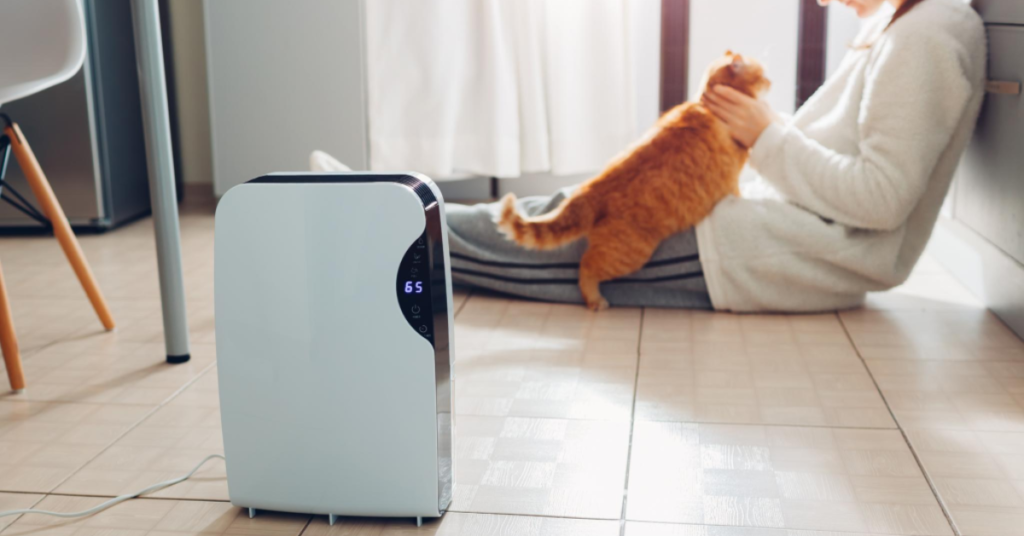
History of Air Purifiers
Invention and Early Developments
Air purifiers have a fascinating history, dating back to ancient civilizations that used various methods to cleanse the air. From the smoky fires of the past to more advanced technologies, we’ve come a long way in our quest for cleaner air.
Evolution of Air Purification Technology
The development of air purifiers didn’t stop with basic filtration. It has evolved over the years, incorporating innovative technologies to address specific air quality issues. From early filtration systems to modern electronic air purifiers, the journey is both exciting and enlightening.
| Era | Air Purification Method | Key Advancements |
|---|---|---|
| Ancient | Natural ventilation and incense | Basic methods to dissipate odors and purify the air |
| 16th – 19th century | Smoking pastilles and perfumes | Introduction of fragrances for air purification |
| 20th century | Mechanical filters and ozone generators | HEPA filters, UV-C technology and electronic purifiers |
| 21st century | Hybrid systems and smart purifiers | Integration with technology and advanced filtration |
Common Types of Air Purifiers
You ust have seen different kinds of air purifiers in market. Following are different types of Air Purifiers.
High-Efficiency Particulate Air (HEPA) Air Purifiers
HEPA Air Prifiers are renowned for their effectiveness in removing tiny particles from the air. They work by forcing air through a fine mesh that traps contaminants. These filters are excellent for allergy sufferers.
Activated Carbon Air Purifiers
Activated carbon air purifiers use a process called adsorption to trap gases, odors and chemicals. They are ideal for kitchens and areas with strong odors.
Ultraviolet Germicidal Irradiation (UVGI) Purifiers
UVGI purifiers use UV-C light to inactivate or destroy microorganisms like bacteria and viruses. They are particularly valuable for germ control in healthcare settings.
Ionic and Ozone Generators
Ionic purifiers release charged ions that attach to airborne particles, making them easier to capture. Ozone generators, on the other hand, release ozone to neutralize odors and pathogens.
Electronic Air Cleaners
Electronic air cleaners use electrostatic charges to capture particles. These can be effective, but maintenance is essential to keep them working efficiently.
Photocatalytic Oxidation (PCO) Purifiers
PCO purifiers use a catalyst to break down contaminants into harmless substances. They are known for their ability to neutralize volatile organic compounds (VOCs).
Hybrid Air Purifiers
Hybrid air purifiers combine multiple technologies for comprehensive air cleaning. They are versatile and efficient, often targeting a wide range of pollutants.
Whole-House Air Purification Systems
These systems are integrated into your HVAC (Heating, Ventilation and Air Conditioning) system to provide whole-house air purification. They ensure that every room in your home benefits from clean air.
Key Features of Common Air Purifier Types
Different kinds of air purifiers have some common features as listed below:
- HEPA Filters: Excellent for removing allergens.
- Activated Carbon Purifiers: Great for odors and chemicals.
- UVGI Purifiers: Effective at germicidal action.
- Ionic and Ozone Generators: Release ions or ozone for purification.
- Electronic Air Cleaners: Use electrostatic charges for particle capture.
- PCO Purifiers: Neutralize VOCs and other pollutants.
- Hybrid Air Purifiers: Combine various technologies.
- Whole-House Systems: Integrate with your home’s HVAC.
HEPA Air Purifiers
HEPA filters are the gold standard when it comes to air purification. Its one of important Types of Air Purifiers. These filters are designed to trap particles as small as 0.3 microns with 99.97% efficiency. In essence, they can capture dust, pollen, pet dander and even some bacteria and viruses.
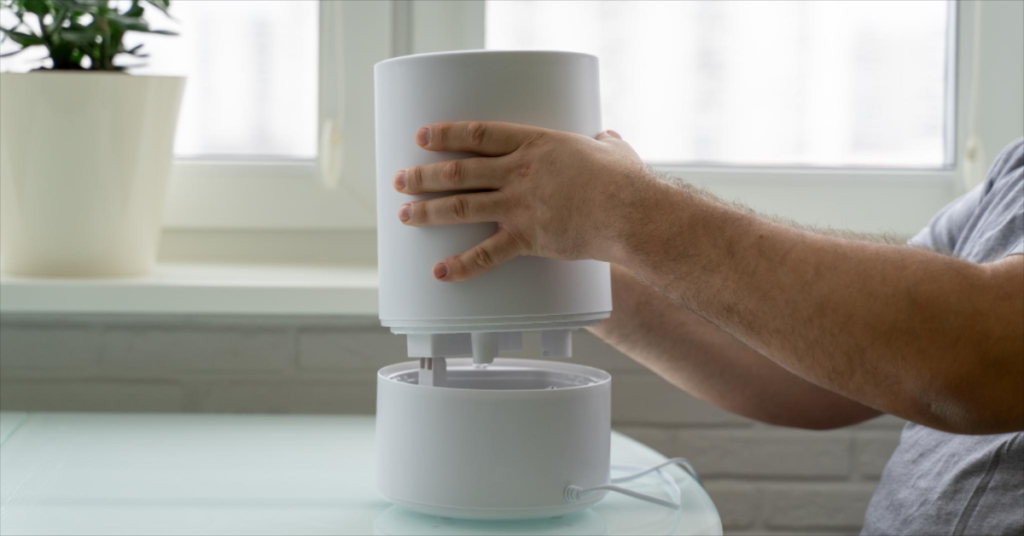
Effectiveness in Removing Particulate Matter
HEPA filters excel in removing particulate matter, making them a top choice for allergy sufferers. They are particularly efficient at reducing allergens and other fine particles that can irritate your respiratory system.
Pros and Cons of HEPA Air Purifiers
Pros:
- Exceptional particle removal efficiency: HEPA Air Purifiers are like expert cleaners for the air. They’re incredibly good at trapping tiny things you can’t even see, like dust, pollen and even the smallest germs. This means they make the air in your home much cleaner and healthier.
- Ideal for allergy and asthma sufferers: If you have allergies or asthma, HEPA purifiers are like your trusty sidekicks. They grab allergens like dust mites and pollen, which are common triggers for sneezing and breathing problems. Having a HEPA purifier can help you feel better and breathe easier.
- Reliable and well-established technology: Think of HEPA purifiers as the tried-and-true experts in air cleaning. They’ve been around for a long time and they’ve earned a solid reputation for being reliable and effective. When you have a HEPA purifier, you can trust that it will do its job well.
Cons:
- Limited in Removing Gases and Odors: HEPA Air Purifiers are like superheroes against tiny particles, but when it comes to gases and odors, they’re not the best crime-fighters. If your primary concern is dealing with unpleasant smells or chemical fumes, you might need a different air purifier, like an Activated Carbon Purifier, that specializes in that.
- Requires Regular Filter Replacement: Just like even superheroes need to rest and recharge, HEPA filters also need some care. You have to change the filters every now and then to keep the purifier working at its best. It’s an added expense and something to remember.
- Slightly More Expensive: Compared to some other types of air purifiers, HEPA purifiers might be a tad more expensive upfront. However, remember that their efficiency in capturing tiny particles and their reliability can make them a worthwhile investment in the long run.
Activated Carbon Air Purifiers
How Activated Carbon Filters Work
Activated carbon is a highly porous material with a large surface area that attracts and absorbs gases and odors. When air passes through, these substances get trapped in the carbon’s tiny pores. This is one of very widely used Types of Air Purifiers.
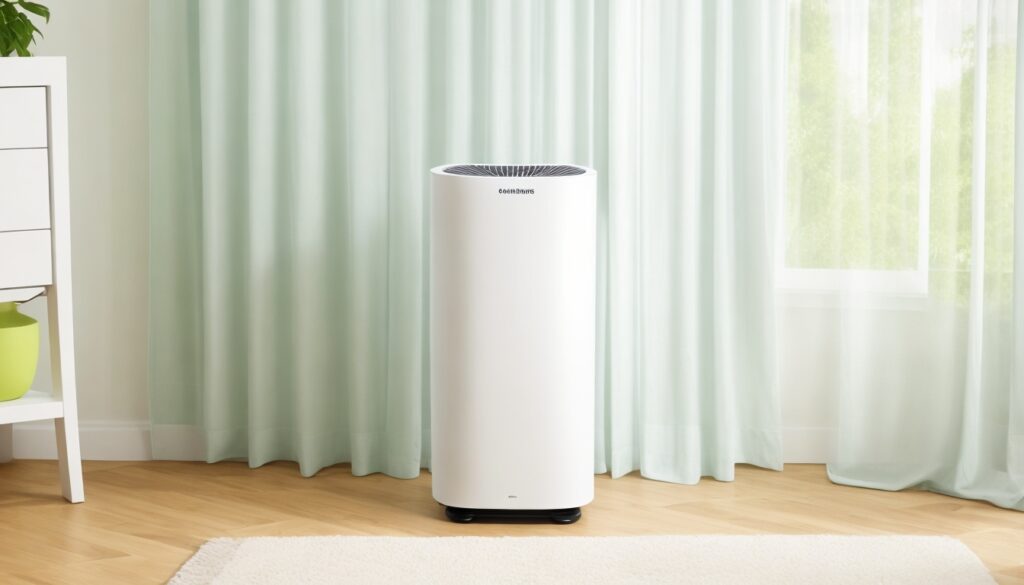
Absorption of Odors and Chemicals
If you’re dealing with cooking odors, chemical fumes or tobacco smoke, activated carbon air purifiers are your best friend. They efficiently eliminate these unwanted scents, leaving your indoor air smelling fresh.
Advantages and Limitations of Activated Carbon Purifiers
Pros:
- Excellent for odor and chemical removal: Activated Carbon Air Purifiers are like odor detectives. They’re really good at capturing bad smells and chemicals in the air, like the stinky odors from cooking or strong cleaning products. So, if you want your home to smell fresh and clean, they’re great allies.
- Long-lasting filters: Activated Carbon Air Purifiers are like odor detectives. They’re really good at capturing bad smells and chemicals in the air, like the stinky odors from cooking or strong cleaning products. So, if you want your home to smell fresh and clean, they’re great allies.
- Silent operation:These purifiers are like quiet ninjas. They work without making much noise, so you can enjoy clean air without any loud humming or buzzing sounds in the background.
Cons:
- Limited particle filtration: Unfortunately, Activated Carbon purifiers aren’t great at capturing tiny particles like dust and pollen. If you’re looking to reduce allergies, you might want to consider a different type of purifier.
- Ineffective against germs and viruses: They also can’t do much against germs and viruses. If you’re concerned about staying healthy, you might need an additional purifier with a different superpower.
- Not suitable for allergen removal: If you have allergies, these purifiers might not be your best choice. They’re more about keeping the air smelling nice and trapping chemicals.
UVGI Purifiers
UV-C Light Technology
UVGI purifiers use UV-C light, which has germicidal properties. It damages the DNA of bacteria, viruses and other microorganisms, rendering them harmless.
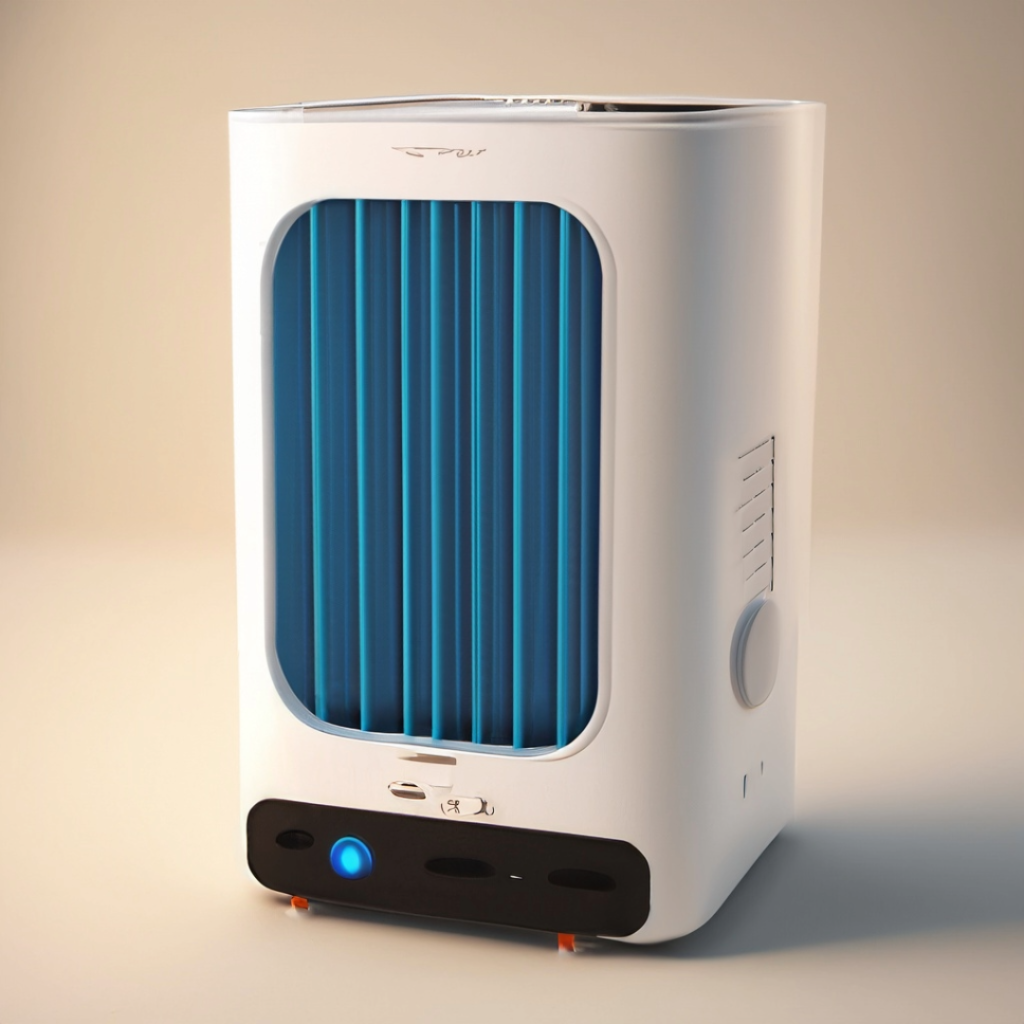
Germicidal and Sterilization Capabilities
These purifiers are exceptionally efficient at killing germs and viruses, making them a popular choice for healthcare settings, offices and homes where germ control is essential.
Safety Concerns and Applications
While UV-C light is highly effective, it can be harmful to the eyes and skin. UVGI purifiers are designed with safety features to prevent exposure. They are best used in unoccupied spaces or with proper precautions in place.
UVGI Purifiers vs. Common Indoor Pathogens
| Pathogen | UVGI Purification Efficiency |
|---|---|
| Bacteria | 99.9% or higher |
| Viruses | 99.9% or higher |
| Mold Spores | 99.9% or higher |
| Dust Mites | Limited effectiveness |
Ionic and Ozone Generators
Ionization Process
Ionic air purifiers release charged ions into the air. These ions attach to airborne particles, making them too heavy to remain airborne. This process effectively removes pollutants from the air. Ozone generators are Types of Air Purifiers that is used with caution beacuase of ozone.

Ozone Generation and Controversies
Ozone generators produce ozone, which can neutralize odors and kill some microorganisms. However, they are controversial due to potential health concerns associated with ozone exposure.
Potential Health Concerns
Ozone can be harmful to humans when present in high concentrations, leading to respiratory issues. For this reason, many experts recommend avoiding ozone generators in favor of safer alternatives.
Electronic Air Cleaners
Electrostatic Precipitators
Electronic air cleaners, also known as electrostatic precipitators, use a different approach to purify the air. They give particles an electric charge and then collect them on oppositely charged plates or filters.
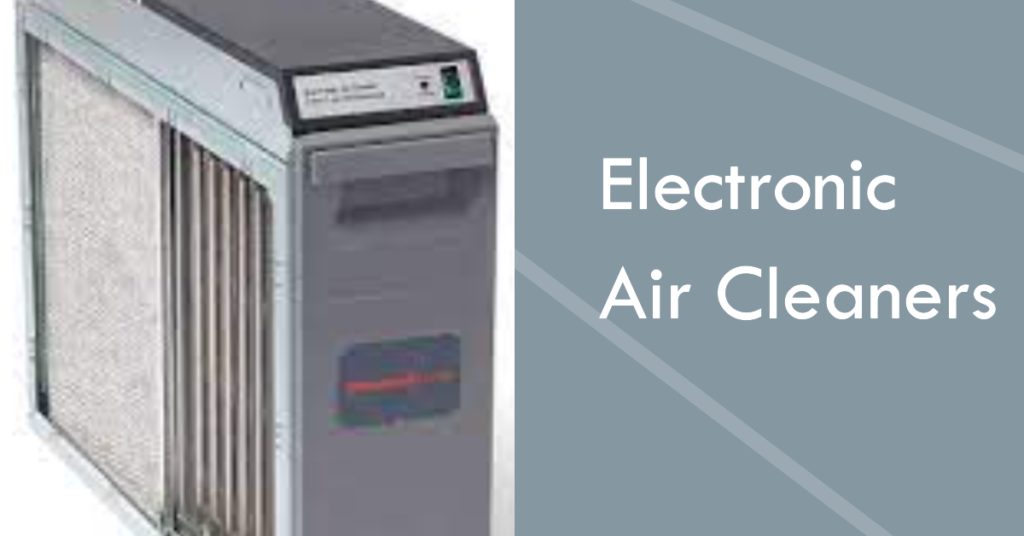
Electrostatic and Charged Particle Collection
The electrostatic process is highly efficient at capturing fine particles, including allergens. These air purifiers are known for their ability to clean the air thoroughly.
Effectiveness and Maintenance
Pros:
- 1. High-Efficiency Particle Removal: Electronic Air Cleaners are like skilled detectives when it comes to capturing tiny particles in the air. They’re incredibly efficient at trapping things like dust, pollen and pet dander, making the air cleaner and healthier.
- 2. Suitable for Those with Allergies: If you or someone in your home has allergies, these air cleaners can be your best pals. They excel at removing allergens that can trigger sneezing and other allergy symptoms.
- 3. Durable and Washable Filters: Think of the filters in these purifiers as long-lasting warriors. You can wash and reuse them, which saves you money in the long run.
Cons:
- 1. Less Effective at Removing Odors: Electronic Air Cleaners are amazing at capturing particles, but they’re not the best at removing odors. So, if you’re dealing with strong smells in your home, you might want to consider a different type of air purifier, like an Activated Carbon Purifier, that specializes in that.
- 2. Ozone Production in Some Models: Ozone is like a double-edged sword. While it can help neutralize odors and certain pathogens, some electronic air cleaners produce ozone, which can be harmful when present in high concentrations. So, be cautious about ozone production and choose models with lower or zero ozone emission.
- 3. Regular Cleaning Required: To keep Electronic Air Cleaners performing at their best, you’ll need to give them regular attention. Cleaning is a bit like maintaining your superhero gear to ensure they stay in tip-top shape.
Photocatalytic Oxidation (PCO) Purifiers
Photocatalytic Oxidation Process
PCO purifiers use a catalyst and UV light to break down airborne pollutants, such as VOCs, bacteria and mold spores. This process converts pollutants into harmless byproducts.
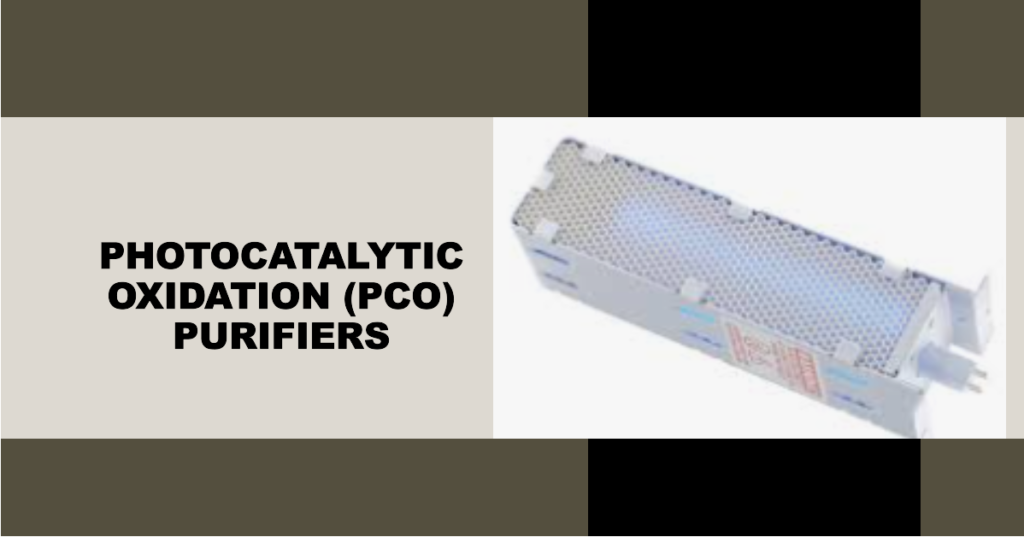
Breakdown of Airborne Pollutants
PCO air purifiers are effective at reducing volatile organic compounds (VOCs), which can be emitted by cleaning products, paints and other household items.
Applications and Performance
Pros:
- 1. Efficient at VOC Removal: PCO Purifiers are like specialists in dealing with invisible enemies called Volatile Organic Compounds (VOCs). These can be released by cleaning products, paints and other household items. PCO purifiers are quite effective at neutralizing them, which is great for maintaining healthier indoor air.
- 2. Safe and Ozone-Free: Think of PCO purifiers as the eco-friendly heroes of the air purification world. They work without producing ozone, which can be harmful at higher levels. So, you get cleaner air without any of the potential health concerns associated with ozone.
- 3. Can Improve Indoor Air Quality Significantly: If you have concerns about chemicals or odors in your home, PCO purifiers can make a noticeable difference in the quality of your indoor air. They can leave your space feeling fresher and healthier.
Cons:
- 1. Limited in Particle Removal: PCO purifiers are like specialized doctors; they focus on certain ailments (VOCs) and may not be great at addressing other issues. They’re not as effective at capturing particles like dust and pollen.
- 2. Reduced Effectiveness Over Time: PCO purifiers can lose some of their superhero powers over time. The catalyst they use might become less effective, so regular maintenance is essential to keep them doing their job well.
- 3. Regular Maintenance Required: Just like heroes need to stay in good shape to fight crime, PCO purifiers need regular maintenance to work at their best. This means you’ll need to pay attention to them and take care of them.
Hybrid Air Purifiers
Combining Multiple Technologies
Hybrid air purifiers are designed to maximize air cleaning efficiency by combining two or more air purification methods. This approach ensures comprehensive pollutant removal.
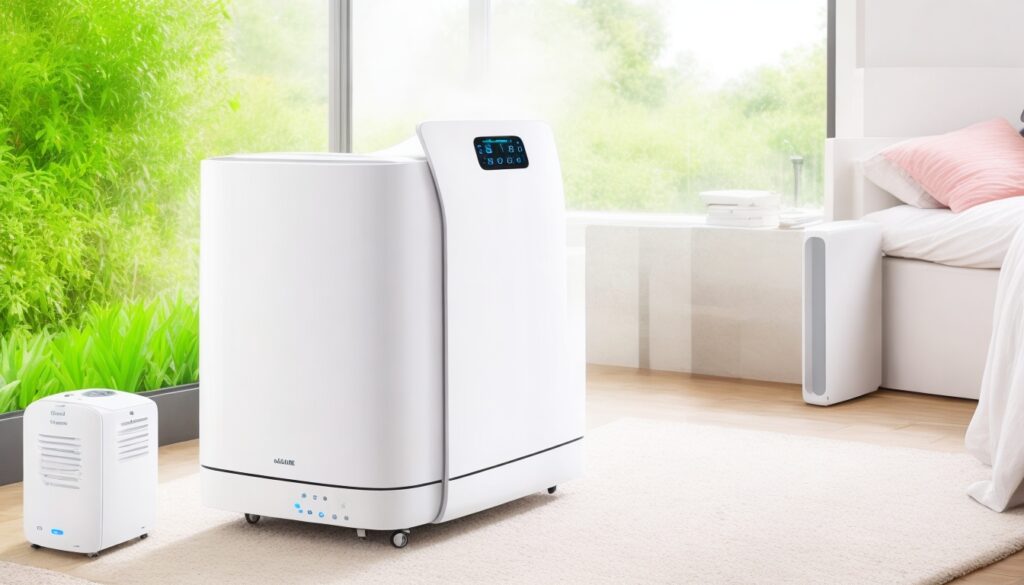
Enhanced Air Cleaning Efficiency
By harnessing the strengths of multiple purification methods, hybrid air purifiers provide better results when it comes to cleaner, healthier air.
Use Cases and Benefits
Hybrid purifiers are versatile and can address a wide range of air quality issues, making them suitable for various indoor environments, from homes to offices.
Benefits of Hybrid Air Purifiers
| Benefit | Explanation |
|---|---|
| Comprehensive Air Cleaning | Combines multiple technologies for thorough purification. |
| Versatility | Suitable for addressing various air quality concerns. |
| Improved Air Quality | Enhanced efficiency results in cleaner indoor air. |
Whole-House Air Purification Systems
Integration with HVAC Systems
Whole-house air purification systems are integrated into your home’s HVAC (Heating, Ventilation and Air Conditioning) system. They work in synergy with your HVAC to clean and circulate air throughout your entire home.
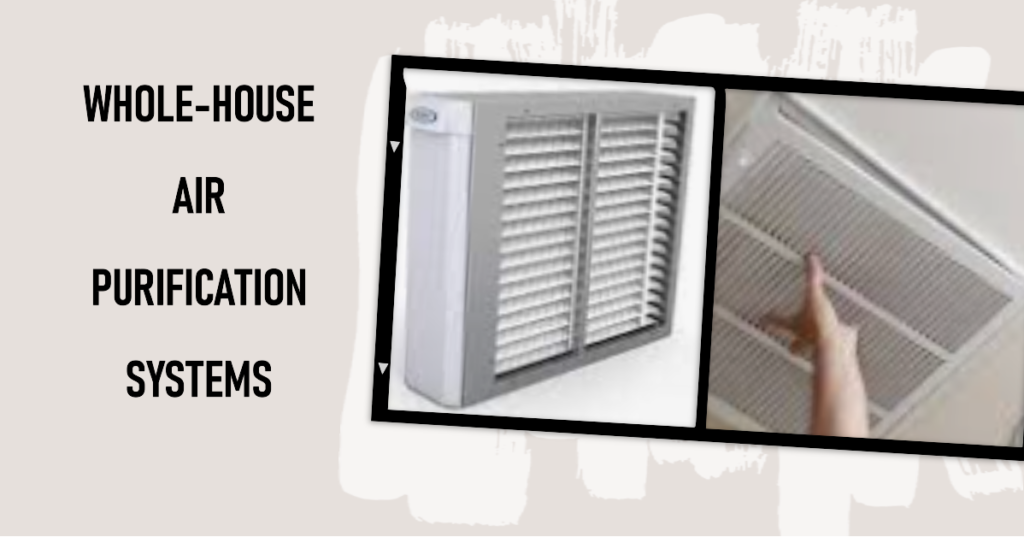
Air Quality Improvement Throughout the Home
Unlike portable air purifiers that focus on single rooms, whole-house systems ensure every corner of your home benefits from clean and purified air. This is particularly useful for larger homes or those with central HVAC systems.
Considerations for Installation and Maintenance
Installing a whole-house system requires professional assistance and maintenance is crucial to ensure its continued effectiveness. These systems often use different purification methods and the choice depends on your specific air quality needs.
Factors to Consider When Choosing different Types of Air Purifiers.
Room Size and Coverage Area
The size of the room you intend to place the air purifier in is a critical consideration. Air purifiers are designed to cover specific square footage, so choose one that matches the size of your room.
Specific Allergies or Sensitivities
Consider your unique needs. If you have allergies to pet dander, pollen or dust mites, opt for an air purifier with a HEPA filter. If you need odor removal, an activated carbon air purifier might be a better choice.
Noise Levels
Some air purifiers can be noisy, while others operate quietly. If you plan to place one in your bedroom or a quiet workspace, opt for a quieter model.
Energy Consumption
Air purifiers, especially larger units, can consume a significant amount of electricity. Look for energy-efficient models to save on operating costs.
Maintenance and Filter Replacement
Regular maintenance is crucial for air purifiers to maintain their effectiveness. Some models have washable filters, while others require filter replacements. Consider the ongoing maintenance requirements.
Comparison of Air Purifier Types
Effectiveness in Removing Allergens
When it comes to allergen removal, HEPA filters and electronic air cleaners are top contenders. They can efficiently capture allergens like dust, pollen and pet dander.
Impact on Indoor Air Quality
Whole-house air purification systems have the most significant impact on indoor air quality since they treat all the air in your home. However, for single-room solutions, hybrid air purifiers tend to provide better results.
Cost and Long-Term Investment
Portable air purifiers are cost-effective upfront, but they come with ongoing filter replacement costs. Whole-house systems may have a higher initial investment but can be a long-term cost-effective solution.
The Future of Air Purification Technology in different kinds of air purifiers
A. Emerging Trends and Innovations
The world of air purification is constantly evolving. As we look to the future, we can expect several exciting trends and innovations in different kinds of air purifiers:
- Smart Air Purifiers: The integration of smart technology with air purifiers will continue to grow. These devices can be controlled remotely through smartphones and can even adjust their operation based on real-time air quality data.
- Improved Filtration: Advances in filter technology will lead to even more efficient removal of particles and contaminants. Nanotechnology and new materials will enhance filtration capabilities.
- Modular Air Purification: Modular air purifiers, where you can customize the purifier based on your specific needs, are gaining popularity. Users can mix and match filtration modules for tailored solutions.
- Air Quality Sensing: Air purifiers with built-in air quality sensors will become more common. These sensors detect pollutants and adjust the purification level accordingly, ensuring consistent clean air.
B. Sustainable and Eco-Friendly Designs
As environmental awareness grows, air purifier manufacturers are also focusing on creating sustainable and eco-friendly designs:
- Energy Efficiency: Future air purifiers will prioritize energy efficiency, reducing electricity consumption and operating costs. Look for models with Energy Star certifications.
- Recyclable Materials: Manufacturers will use recyclable and eco-friendly materials in their designs. This approach ensures that the environmental impact of air purifiers is minimized.
- Long-Lasting Filters: Filter designs will improve to extend their lifespan. Long-lasting filters mean fewer replacements and less waste.
- Reduced Ozone Emission: Ozone generation, which has been controversial, will become more controlled to meet strict emission standards. Manufacturers will focus on minimizing or eliminating ozone emissions.
Conclusion
In this comprehensive guide of Types of Air Purifiers, we’ve journeyed through the world of air purifiers, starting with their definition and importance. We explored the history of air purification, the common different types of air purifiers and what makes each type unique. We also discussed vital factors to consider when choosing different kinds of air purifiers and compared their effectiveness in various scenarios.
Selecting the right types of air purifiers is not just about finding a device; it’s about securing clean, healthy air for your home. Your choice should align with your specific needs, from allergies to odors to overall air quality. The air you breathe directly impacts your well-being, making the selection of an air purifier a significant decision.
Clean and healthy indoor air is not a luxury; it’s a necessity. Your choice of an air purifier can have a profound impact on the quality of the air you breathe daily. It’s essential to select an air purifier that addresses your unique air quality needs, whether it’s allergens, odors or contaminants. Making a well-informed choice ensures that you and your loved ones can breathe easy and live in a healthier, more comfortable environment.
FAQ on Different Types of Air Purifiers
What is the best air purifier method?
The best air purifier method depends on your specific needs. HEPA filters are excellent for capturing particles, while activated carbon filters are great at removing odors and chemicals. The best method varies based on your air quality concerns.
Is a HEPA filter better than an air purifier?
HEPA filters are a key component of many air purifiers, so they are not better or worse; they serve different purposes. A HEPA filter is effective at removing airborne particles, while an air purifier may use additional methods, like activated carbon, to address odors and chemicals.
Do air purifiers help with mold?
Yes, air purifiers can help with mold. High-efficiency particulate air (HEPA) filters can capture mold spores and some purifiers may also include ultraviolet (UV) technology to kill mold and prevent it from spreading.
What is the difference between HEPA and carbon air purifier?
The main difference between a HEPA and a carbon air purifier is their primary function. HEPA purifiers are focused on removing airborne particles, while carbon purifiers primarily target odors, chemicals and gases using activated carbon filters. Some air purifiers combine both HEPA and carbon filters for comprehensive air cleaning.
What to avoid when buying an air purifier?
When buying an air purifier, avoid making these common mistakes:
Choosing the wrong type for your specific needs.
Neglecting to check the Clean Air Delivery Rate (CADR) to ensure it’s suitable for your room size.
Not considering the noise level, especially if you plan to place it in a quiet room.
Overlooking the cost of replacement filters or other ongoing expenses.
What is the #1 air purifier?
There isn’t a single “#1” air purifier that suits everyone, as the best one depends on your specific needs. Brands like Dyson, Honeywell and Blueair have popular models. The best air purifier for you is the one that effectively addresses your air quality concerns, whether that’s allergies, odors or specific pollutants.
Where is the best place to put an air purifier?
The best place to put an air purifier is in the room where you spend the most time. Common locations include bedrooms, living rooms or home offices. Ensure the purifier has proper airflow and isn’t obstructed by furniture. For targeted air cleaning, you can also place it near the source of pollutants, like a kitchen or a pet area.
What are the three methods used for air purification?
The three common methods used for air purification are:
Mechanical Filtration: This includes HEPA filters that capture particles.
Adsorption: Activated carbon or other adsorbents that trap gases and odors.
UV-C Sterilization: Using ultraviolet light to inactivate or destroy microorganisms like bacteria and viruses.
Can an air purifier clean a whole house?
Whole-house air purifiers are designed to clean the air in your entire home. They are typically integrated into the HVAC system and provide comprehensive air purification throughout all rooms. However, standalone air purifiers are typically room-specific and may not effectively clean the air in an entire house unless they have a high Clean Air Delivery Rate (CADR) and are used in central locations.
DheerajSonwane is a dedicated writer with expertise in air purification technologies. He focuses on providing well-researched content to help readers improve indoor air quality in homes and businesses. As the lead writer at AirPurifierMaster.com, Dheeraj offers practical advice his insightful reviews guide individuals in choosing the best air purifiers for their needs.


1 thought on “Types of Air Purifiers : A Consumer’s complete useful Handbook”